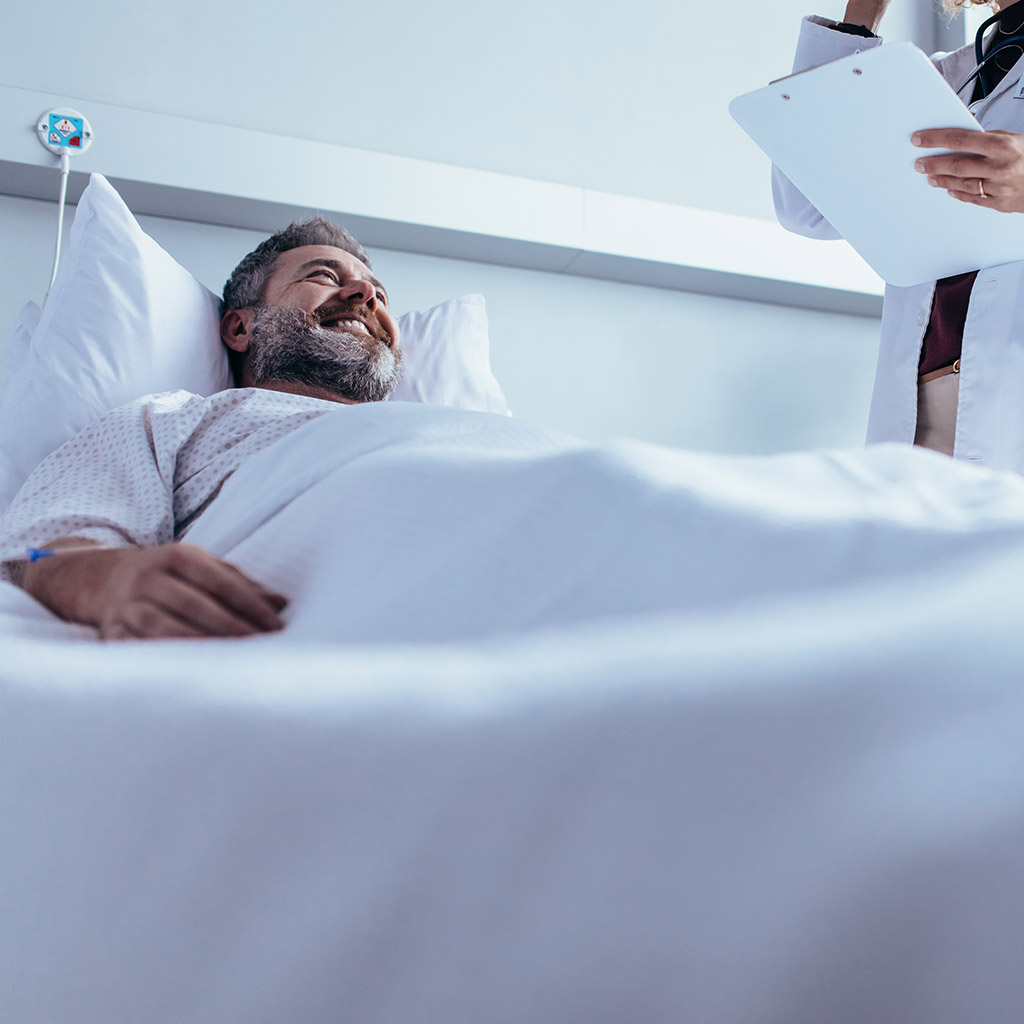Radical Removal of the Bladder and Fashioning of an Ileal Conduit
Male
The Procedure
This procedure is also known as radical cystoprostatectomy and formation of ileal conduit. It involves removal of the entire bladder, the prostate, the seminal vesicles (sperm sacs) and pelvic lymph nodes with permanent diversion of urine to the abdominal skin using an isolated loop of bowel as a stoma
A full general anaesthetic will be used and you will be asleep throughout the procedure. In some patients, the anaesthetist may also use an epidural anaesthetic to minimise post-operative pain.

In the operation, the bladder, the prostate, the seminal vesicles (sperm sacs) and, if necessary, the urethra (water pipe) are removed. Almost invariably, the nerves which control erections are damaged as they run very close to the prostate; sometimes it is possible to preserve these nerves and this may be discussed with you beforehand.
The ureters (the tubes which drain urine from the kidneys to the bladder) are then sewn to an isolated segment of small bowel which is positioned on the surface of the abdomen as an opening called a urostomy or stoma. The ends of the small bowel, from which the conduit is isolated, are then joined together again.
After your operation, you may be in the Intensive Care Unit or the Special Recovery area of the operating theatre before returning to the ward. You will have a drip in your arm and a further drip into a vein in your neck.
You will be encouraged to mobilise as soon as possible after the operation because this encourages the bowel to begin working and helps to prevent deep vein thrombosis.
We will start you on fluid drinks and food as soon as possible but this may take several days.
You will usually have two tube drains in your abdomen and two fine tubes which go into the kidneys via the stoma to help with healing. Normally, we use injections and elastic stockings to minimise the risk of a blood clot (deep vein thrombosis) in your legs. A physiotherapist will come and show you some deep breathing and leg exercises, and you will sit out in a
chair for a short time soon after your operation. It will, however, take at least 2 months, and possibly longer, for you to recover fully from this surgery.
The average hospital stay is 14 days.
Most procedures have a potential for side-effects and these are outlined below. Please use the check boxes to tick off individual items when you are happy that they have been discussed to your satisfaction:
Common (greater than 1 in 10)
- Temporary insertion of a stomach tube though the nose, a drain and ureteric stents ␣ High risk of impotence (lack of erections).
- Dry orgasm with no semen produced causing infertility.
- The cancer may not be cured with removal of bladder alone.
Occasional (between 1 in 10 & 1 in 50)
- Infection or hernia of the incision requiring further treatment.
- Need to remove the penile urinary pipe urethra) as part of the procedure.
- Blood loss requiring blood transfusion or return to the operating theatre.
- Decreased kidney function with time.
- Diarrhoea/vitamin deficiency due to shortened bowel requiring treatment.
- Long term metabolic abnormalities requiring readmission to hospital or further outpatient treatments such as acidosis of the blood or Vitamin B deficiencies.
- Abdominal adhesions causing bowel obstructions requiring admission to hospital or other operations.
Rare (less than 1 in 50)
- Anaesthetic or cardiovascular problems possibly requiring intensive care admission (including chest infection, pulmonary embolus, stroke, deep vein thrombosis, heart attack and death).
- Bowel and urine leakage from the internal connections or anastomoses which may require intervention such as surgery.
- Scarring to the bowel or ureters requiring operation in future.
- Scarring, narrowing or hernia formation around stomal opening requiring revision.
- Intra-operative rectal injury requiring colostomy.
You will find that your energy levels are low when you get home and you will require assistance with many of the daily activities you normally take for granted.
The wound clips will be removed in hospital or by the District Nurse.
You will be contacted by the District Nurse to help you with the management of your stoma. You may experience problems with the stoma appliance in the early days, especially with leakage at night. As you become more familiar with your stoma and its fittings, this aspect will become less of a problem.
The time taken to return to normal activity is between 2 and 4 months.
It will be at least 14-21 days before the pathology results on the tissue removed are available. It is normal practice for the results of all biopsies to be discussed in detail at a multi-disciplinary meeting before any further treatment decisions are made. You and your doctor will be informed of the results after this discussion.
There are a number of complications which may make you feel unwell and may require consultation with your GP or contact with the Urology Department.
If you experience fever or vomiting, especially if associated with unexpected pain in the abdomen, you should contact your doctor immediately for advice.
If you have any problems relating to the stoma or its attachments, you should contact the District Nurse or the Urology Department.

